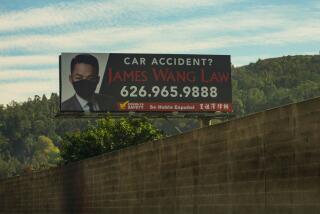Car Ads Sell the Fantasy, Not Facts : In car advertising, the heart is more important than the head. The subliminal message is: You are what you drive.
- Share via
Truth be told, Hot Wheels and Acuras have very little in common. (When was the last time you tripped on your kid’s Integra in the middle of the night?)
But in the world of automotive advertising--where truth is what you make it--the two are both just toys, although for kids of different ages.
So it made perfect sense to Acura’s ad folks when they struck upon the idea of comparing the sporty Integra to the miniature die-cast cars. An advertisement last year showed the Acura speeding along the Hot Wheels’ trademark orange plastic track and then hurtling upside-down around a loop as the voice-over pronounced the coupe the most fun since Hot Wheels.
“All of us remember growing up playing with Hot Wheels,” said Tim Hart, executive vice president of the advertising firm that created the spot, Ketchum Communications. “We wanted to duplicate that emotion so people remember Hot Wheels and say, ‘That’s the kind of car I want to be in.”’
Indeed, selling cars these days is often less about what’s under the hood than it is about how the vehicle reflects on the driver. Car makers spend $3 billion a year on advertisements that promise not only good brakes and a dependable engine but, more prominently, excitement, freedom and sex.
Pontiac now builds “excitement.” Mazda has a “passion for the road.”
“The car is sold as more than just practical transportation,” said Dartmouth College history professor Ron Edsforth, an expert on cars in American culture. “The car has always had this character as an object that is just as important for its symbolic value. . . . The car enables you to project yourself as something you may think you’re not.”
In other words, you’re delusional if you think you bought that red convertible with the shoebox-size trunk just because it gets great mileage and is easy to park. Cars create instant public images, read in a flash at 65 mph: I’m hip. I’m rugged. I love my kids. I read Consumer Reports. I question my manhood. You may have seen me on “Cops.”
“It’s been proven in psychological studies that the car is often an extension of the self,” said Eugene Fram, the J. Warren McClure research professor of marketing at Rochester Institute of Technology. “When you see a 60-year-old man driving a souped-up car, they are clearly making a statement that they don’t want to be 60. They want to be 25.”
Advertisers know this--and prey on it as they try to make their pitch stand out in the 600 to 1,200 messages the average American is bombarded with every day.
Hart points out that some of the most successful ads never mention anything about the car’s features.
Part of this is a function of the car market itself. As quality improves and features are standardized, buyers expect vehicles to last longer than 50,000 miles, start reliably and not rattle and squeak within weeks of driving off the lot.
Sometimes, attitude is all that distinguishes cars within the same class from one another. In many ways, it has always been like this. From the first days of driving, fantasy was as much a part of car buying as function.
Car companies once sponsored racing teams to show off and promote their products--a theme that remains in ads for even the most upscale, uptight wheels on the road. Your Cadillac now not only accommodates your ever-wider behind, but can also lay a streak of rubber when it counts.
Edsforth said his young sons often find the car commercials more interesting and exciting than the shows they sponsor, although he cautions them that real people don’t drive that way.
“I’ve never heard anyone say they were afraid of making their ads too exciting,” said Steve Gelsi, who covers automotive marketing for the trade magazine Brandweek. “They are appealing to the little boy in all of us who wants to go fast.”
Sometimes, though, catering to that impulse comes under fire.
Driving safety experts were annoyed a few months ago over a Nissan ad in which a driver zips out into oncoming traffic to pass a slow-moving trailer and is confronted instead by the grill of an oncoming semi.
The ad boasts that although the Maxima is equipped with two air bags, the beefy engine means drivers are less likely to need them. With that, the car swoops back into the correct lane and narrowly escapes being turned into street pizza.
That annoyed the safety moguls, who complained that the ad encouraged unsafe driving.
But, really, it was just an ad. And ads, by their nature, are designed to raise adrenaline, their defenders would argue, not train adolescents in drivers education classes. When was the last time you drove your Isuzu through a giant birthday cake? Or scaled a skyscraper with your Lexus? Or cruised across a lake in your Mercedes?
Or took your Acura on a loop-the-loop?






